 |
Znanstveno-stručni
časopis Hrvatskog druątva za geometriju i grafiku Scientific and Professional Journal of the Croatian Society for Geometry and Graphics |
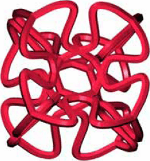 | Sybille Mick, Otto Röschel (mick@tugraz.at)
Frameworks Generated by the Octahedral GroupThe paper is devoted to the generation of frameworks of polyhedra as ornaments of the octahedral group O. An hierarchical block structure is used to implement the action of O in a CAD-package. The framework is generated by a starting (prismatic) rod as the motif. We will provide a range of examples and discuss the symmetry of the corresponding ornaments.Keywords: Polyhedra, Octahedral Group, Frameworks, Geometric Modeling in CAD-packages  Article in PDF. Article in PDF.
|
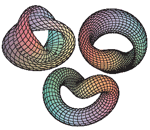 | Daniela Velichová (daniela.velichova@stuba.sk)
Two-Axial Surfaces of RevolutionSpecial class of surfaces, two-axial surfaces of revolution created by the Euclidean metric transformation of a simultaneous revolution about two different axes, is presented in the paper. Three specific subclasses of surfaces are classified with respect to the superposition of the two axes 1o, 2o of revolution. There are defined several types of two-axial surfaces of revolution specifying the type of the surface basic figure and its position to the axes of revolution.Keywords: composite revolution, two-axial revolution, generalised surfaces of revolution  Article in PDF. Article in PDF.
|
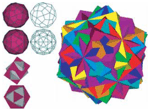 |
László Vörös (vorosl@witch.pmmf.hu)
Regular Bodies and HypercubesThe paper gives useful connections between regular bodies, bodies originated from them and the 2D and 3D projections of multidimensional cubes. The problem of graphic representation has been solved with AutoCAD and Autolisp programs which we developed.Keywords: multidimensional axonometry, zonotopes, Minkowski sum  Article in PDF. Article in PDF.
|
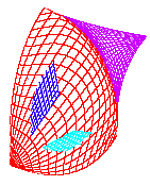 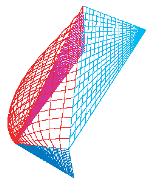 |
Márta Szilvási-Nagy, Ildikó Szabo (szilvasi@math.bme.hu)
C1-continuous Coons-type blending of triangular patchesA Gordon-Coons-type surface construction starts from three differentiable triangular surface patches, which are defined on the same triangular parameter domain. If one boundary curve of each fits a curvilinear triangle, then the defined surface interpolates to these curves. The connection between the resulting surface and the constituents is C1 continuous along the common boundary curves with the exception of the corner points. This surface definition is an extension of the Gordon--Coons definition of a triangular surface patch constructed from three boundary curves.Keywords: blending surface, surface modelling, CAGD  Article in PDF. Article in PDF.
|
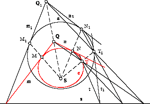 |
Ana Sliepčević, Jasna Kos-Modor (anas@grad.hr)
Some Planimetric Constructions in the H-planeOn the Klein's model of the hyperbolic plane we can define the central collineation between absolute and H-circle. Using that central collineation it's possible to make the elementary geometric constructions in the H-plane by the instruments of the euclidean geometry. Two problems have been solved in this way.Keywords: hyperbolic geometry, hyperbolic circle, central collineation  Article in PDF. Article in PDF.
|
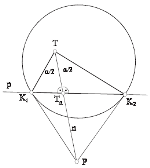
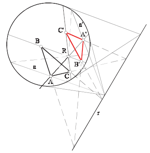 |
Ivanka Babić (ibabic@tvz.hr)
Some collineations of H-planeOn the Klein's model of the hyperbolic plane the harmonic homology is defined. This collineation maps absolute points of the h-plane onto absolute points, real points onto real points and ideal points onto ideal points. It is called line symmetry if the center of collineation is ideal point and point symmetry if the center is real point, because described mappings have equal properties as the analogues mappings in the Euclidean plane. By using point and line symmetries, symmetric images of the lines, points and triangles, bisectors of the angles and perpendicular bisectors of the segments are constructed. At the end one complicated metric problem is solved.Keywords: hyperbolic plane, Klein's model of the hyperbolic plane, central involutory collineation  Article in PDF. Article in PDF.
|
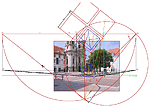
 |
Milena Stavrić, Albert Wiltsche, Heimo Schimek (mstavric@tugraz.at)
New Dimension in Geometrical EducationThis paper describes the course "Methods of representation" that has evolved at the Faculty of Architecture in Graz in conjunction with developments in the modern practice of architectural design. We established web sites (http://www.geometrie.tugraz.at/lehre/dm\_ue03/ and http://ikg.tugraz.at/dm0/ws04/), which include the introduction in teaching, tutorials and VRLM animations to help students understanding space geometry. The course focuses on classical geometrical representation methods, solid modelling in CAD and geometrical freehand drawing. Each of these parts will be worked out and examples of student exercises will complete the paper.Keywords: descriptive geometry education, CAD, visual communication  Article in PDF. Article in PDF.
|
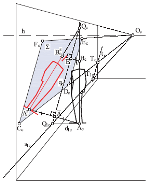 |
Nikoleta Sudeta, Marija ©imić (nikoleta.sudeta@arhitekt.hr)
Reflections in PerspectiveThe paper gives an overview of the constructions of reflections in perpective with horizontal line of sight. A few examples are represented depending on the position of the reflecting plane S with respect to the horizontal plane and picture plane P. Reflecting surface can be perpendicular to the picture plane P or inclined to it. The solutions of those examples are reached by applying the basic rule of geometrical optics and equivalent angles.Keywords: reflections in perspective, normals to the reflecting plane, vanishing points, equivalent angles  Article in PDF. Article in PDF.
|
 |
Predrag Lončar (ivan.loncar1@vz.htnet.hr)
About the Invariants of 4th Degree PolynomialIn this paper invariants of the polynomial of the fourth degree over the field of real numbers (discriminant and some others) are studied. As a consequence, some elementary inequalities are obtained and some characteristic graphs of these polynomials are drawn.Keywords: polynomial, invariants  Article in PDF. Article in PDF.
|
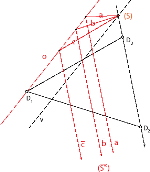 |
Aleksandar Čučaković (cucak@grf.bg.ac.yu)
Constructive Procedure for Transformation of Collinear SpacesThis paper offers the constructive solution for transformation of points between two general collinear spaces S and S by using Monge's projection. The constructive procedure is based on the fact that each straight line of space S which is parallel to vanishing plane R ÎS and one side of autocollinear tetrahedron D1D2D3D4, is transformed into the straight line of space S which is parallel to vanishing plane QÎ S and the same side of autocollinear tetrahedron.Keywords: collinear spaces, autocollinear tetrahedron, vanishing plane, perspectivity of the pencils of lines  Article in PDF. Article in PDF.
|